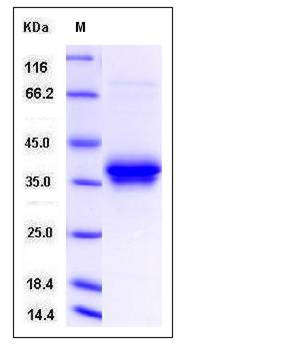Human TNFRSF12A / FN14 / TWEAKR Protein (Fc Tag)
CD266,FN14,TWEAKR
- 100ug (NPP3872) Please inquiry
| Catalog Number | P10431-H01H |
|---|---|
| Organism Species | Human |
| Host | Human Cells |
| Synonyms | CD266,FN14,TWEAKR |
| Molecular Weight | The recombinant human TNFRSF12A/Fc chimera is a disulfide-linked homodimeric protein. The reduced monomer consists of 313 amino acids and has a calculated molecular mass of 34 kDa. In SDS-PAGE under reducing conditions, the apparent molecular mass of rhTNFRSF12A/Fc monomer is approximately 37 kDa. |
| predicted N | Glu |
| SDS-PAGE |  |
| Purity | > 95 % as determined by SDS-PAGE |
| Protein Construction | A DNA sequence encoding the human TNFRSF12A isoform 1 (Q9NP84-1) extracellular domain (Glu 28-Trp 79) was fused with the Fc region of human IgG1 at the N-terminus. |
| Bio-activity | Immobilized Cynomolgus mFc-TNFSF12 (P90094-C04H) at 10 μg/ml (100 μl/well) can bind human Fc-TNFRSF12A, The ED50 of human Fc-TNFRSF12A is 0.07-0.15 μg/ml. |
| Research Area | Cancer |Signal transduction |Other Related Intracellular Topics |Cellular Senescence and Pathways in Aging |Apoptosis |Extracellular Signals | |
| Formulation | Lyophilized from sterile PBS, pH 7.4 1. Normally 5 % - 8 % trehalose and mannitol are added as protectants before lyophilization. Specific concentrations are included in the hardcopy of COA. |
| Background | Fn14 (tumor necrosis factor receptor superfamily, member 12A), also known as TNFRSF12A, is the receptor for TNFSF12/TWEAK. Fn14 shares 82% amino acid identity with the mouse sequence. It contains a signal peptide, an extracellular domain, a membrane-anchoring domain, and a cytoplasmic domain. In response to FGF1, calf serum, or phorbol ester stimulation of human quiescent fibroblasts in vitro, the level of Fn14 is increased. A 1.2-kb FN14 transcript was expressed at high levels in heart, placenta, and kidney, at intermediate levels in lung, skeletal muscle, and pancreas, and at low levels in brain and liver. In addition, elevated FN14 expression was found in human liver cancer cell lines and hepatocellular carcinoma specimens. Expression of mouse Fn14 was upregulated in hepatocellular carcinoma nodules that develop in 2 different transgenic mouse models of hepatocarcinogenesis. TNFRSF12A is the weak inducer of apoptosis in some cell types. It promotes angiogenesis and the proliferation of endothelial cells. TNFRSF12A may modulate cellular adhesion to matrix proteins. |
| Reference |
